Dictionary.com Unabridged (v 1.1)
mar·vel /ˈmɑrvəl/ Pronunciation Key - [mahr-vuhl] Pronunciation noun, verb, -veled, -vel·ing or (especially British) -velled, -vel·ling.
–noun
1. something that causes wonder, admiration, or astonishment; a wonderful thing; a wonder or prodigy: The new bridge is an engineering marvel.
2. Archaic. the feeling of wonder; astonishment.
–verb (used with object)
3. to wonder at (usually fol. by a clause as object): I marvel that you were able to succeed against such odds.
4. to wonder or be curious about (usually fol. by a clause as object): A child marvels that the stars can be.
–verb (used without object)
5. to be filled with wonder, admiration, or astonishment, as at something surprising or extraordinary: I marvel at your courage.
[Origin: 1250–1300; ME mervel < id="dictionary">
- marvel (n.) c.1300, "miracle," also "wonderful story or legend," from O.Fr. merveille "a wonder," from V.L. *miribilia, alt. from L. mirabilia "wonderful things," from neut. pl. of mirabilis "strange or wonderful," from mirari "to wonder at," from mirus "wonderful" (see smile). A neut. pl. treated in V.L. as a fem. sing. The verb is attested from c.1300. Marvelous (c.1300) is O.Fr. merveillos, from merveille. Weakened sense of "splendid, very nice" is from 1924.
- From the Online Etymology Dictionary
We could talk for days about the species-long history of sequential art, drawn images presented in a chronological series to confer the passage of time. But we're going to skip ahead a couple tens of thousands of years or so now and focus upon the emergence in the late 1930s of the American Comic Book. The comic book was a natural bi-product of the newspaper comic strip industry. Bound collections of strips were available as early as the 1830s. By the 1920s comic strips were being repackaged in magazine format. This format proved popular and over time publishers found that the demand for material was greater then the supply of newspaper strips. Original material started coming into the mix. In 1935 National Allied Publications, the future DC Comics, released "New Fun" #1, an anthology (as nearly all the early comic books would be) mixing funny animal features and adventure stories. Issue number 6 marked the first published comic material of Jerry Siegel and Joe Shuster. In that issue, under the pseudonyms Leger and Reuths, they brought readers Dr. Occult.
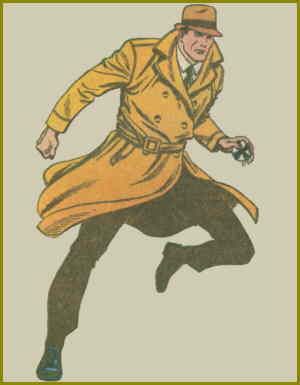
art by Joe Shuster
Dr.Occult was a Sam Spade-type detective who specialized in supernatural matters. He was also known as Dr. Mystic and "the Ghost Detective". He was the agent of the mysterious secret society known as "The Seven". He possessed many supernatural abilities, telepathy, telekinesis, astral projection, etc. Note his red and white Templar Cross-like amulet, the Sign of the Seven, which he used to repel mystical entities and energies. The Seven are introduced to the Dr.Occult story in Centaur Publications' "The Comics Magazine" #1 (as Dr.Mystic) and National's "More Fun Comics" #s 14-17. This adventure also makes Dr.Occult the first caped super hero, as he enters an Other World where he dons a red cape and flies.
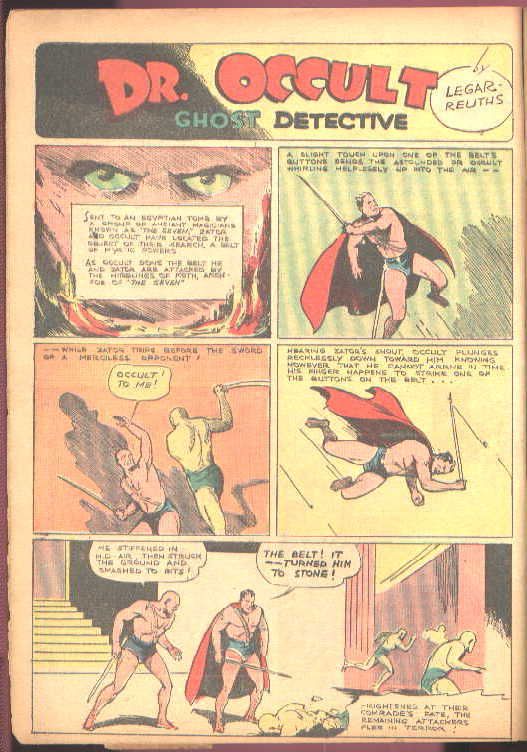
art by Joe Shuster
If all of this wasn't interesting enough, Dr.Occult's girlfriend was blatantly named Rose Psychic. Over fifty years later author Neil Gaiman added an interesting alchemical attribution to the enigmatic Doctor in his proto-Harry Potter DC series "The Books Of Magic" where Dr.Occult and Rose Psychic are depicted as the male and female forms of a gestalt being.

art by Charles Vess
I present Dr.Occult to you in such detail because I find it noteworthy that this highly esoterically symbolic character is the little-known progenitor of the super hero genre. Dr. Occult's role is overshadowed by a far more famous creation of Siegel and Shuster, perhaps the most recognizable American icon of the modern era, Superman (note however that while Superman is undoubtedly an emblem of American culture, his initial Illustrator Joe Schuster was a Canadian).
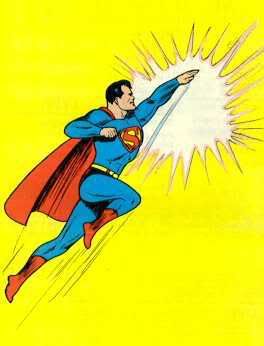
art by Joe Schuster
We're all well familiar with the modern, solar-deity mythos of Superman so I won't belabor details on the character. One interesting aspect I do wish to touch upon is the name of Superman's secret identity, Clark Kent. The name Clark was chosen due to the popularity of movie star Clark Gable. Clark Gable also provided the name for an earlier, and nearly as important hero Doc Savage, Clark Savage, Jr.
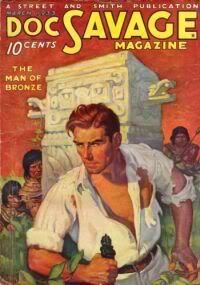
art by Walter Baumhofer
Besides sharing a first name, Kent and Savage both also operate out of an Arctic base known as a Fortress of Solitude. Of interest here however is the underlying symbol of Cosmological Age Shift that exists between these two figures. Doc Savage, preeminent hero of the Pulp Era is "The Man of Bronze". Superman, popularly the father of all super heroes, is well known as "The Man of Steel", a modernized way of saying "The Man of Iron". The Iron Age follows the Bronze Age in the Great Cycle's natural progression.
Now we can enter into the matter at hand, the prolific yet mysterious use of the term "Marvel" in American comic books. Super hero comic books proved a smash success and multiple publishers entered the marketplace almost immediately. Amongst them was Timely Publications whose initial release in 1939 was "Marvel Comics" #1. This issue included an adaptation of the Tarzan clone Ka-Zar (both Dionysian or Cernunnos-type figures), and the first appearance of the original super hero to use the name The Angel. Perhaps most notable is the fact that "Marvel Comics" #1 introduced both Carl Burgos' Promethean/Frankenstein combination (note Mary Shelly's Frankenstein was also titled "The Modern Promethean") The Human Torch, and Bill Everett's Hermetic mutant Atlantean Namor, the Sub-Mariner
Everett, it is well-worth noting, was also known as William Blake, and was a direct descendant of the famous 19th century Symbolist illustrator/poet.
Around the same time that Timely published "Marvel Comics" #1, illustrator C.C.Beck and writer Bill Parker were creating a Marvel of their own, Captain Marvel. Captain Marvel was first published by Fawcett Comics in 1940's "Whiz Comics" #2.
Captain Marvel, popularly referred to by the word "Shazam!", both his benefactor and his power activating magic word, was one of many early American comic characters designed along the Superman vein. But Captain Marvel was not a simple Superman clone. For one thing his alter ego was Billy Batson, in the news field like Clark Kent, but a child roughly 10-12 years old. Additionally, while Superman's great powers derived from his extraterrestrial origin, Captain Marvel's powers were based upon magic, specifically an invocation to the gods. Billy is chosen by the ancient wizard Shazam to be an avatar of righteousness. Guided into a subway station and taken to a deep underground cavern by a train without a driver, Billy meets the wizard who casts an enchantment on the boy. From that point on whenever Billy speaks the wizards name he is struck from above by a bolt of lightning and transformed into Earth's Mightiest Mortal. Shazam is an acronym of the six sources of Captain Marvel's abilities, the Wisdom of Solomon, the Strength of Hercules, the stamina of Atlas, the Power of Zeus, the Courage of Achilles, and the Speed of Mercury.
Amongst the characters introduced in Whiz Comics #2 was Ibis the Invincible, the resurrected ancient Egyptian prince Amentep, gifted by the god Thoth with the "Ibis-Stick", a magic wand that can do pretty much anything.
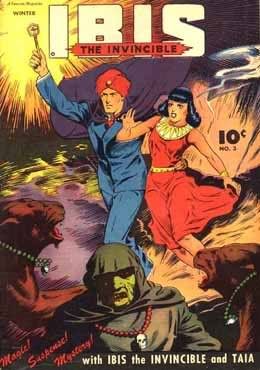
art by Bob Kingett
Whiz Comics #1 was a quickly printed ashcan published in order to secure the title for Fawcett. Amongst the other titles proposed for the anthology series was "Flash Comics", unavailable because All-American Comics (one of the companies that would merge with National to form DC) beat them to it with the issue that introduced Gardner Fox's Hermetic speedster The Flash. Note how with both characters we see the golden bolt of enlightenment as a character emblem, played upon a red field.
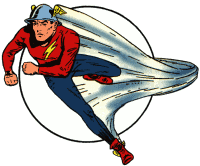
art by Harry Lampert
Captain Marvel's adventures proved highly popular with comic book readers, at times outselling titles featuring Superman. Soon the Captain was joined by Captain Marvel Jr. (Elvis Presley's favorite hero and the inspiration for much of his costuming) and the Captain's long-lost sister Mary Marvel, which, as far as I'm concerned, is a name which may as well be Mary of Mary (for Mary Marvel saying "Shazam!" grants her the Grace of Selena, the Strength of Hippolyta, the Skill of Ariadne, the Speed of Zehyrus, the Beauty of Aurora and the Wisdom of Minerva).
The success of Captain Marvel was such that National pursued a lawsuit against Fawcett stating the Captain was a copyright infringement of the Superman character, who was similarly dressed and powered (and whose creators were paid next to nothing for their intellectual property, go figure). The case went on for years. Eventually Fawcett settled, more due to flagging comic book sales in the early fifties then the merits of the lawsuit. DC would go on to acquire Captain Marvel and friends in the early 70s and eventually folded the Fawcett Universe into the DC Universe.
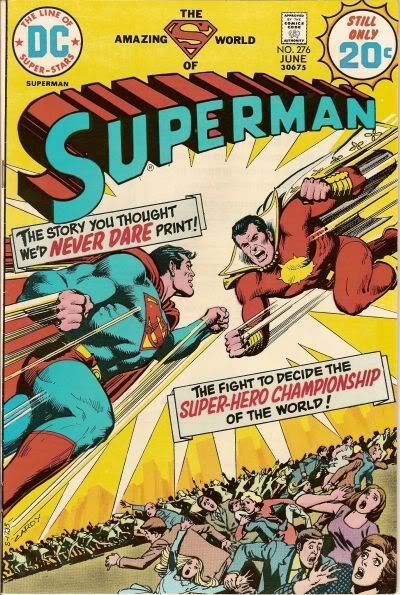
Can't we all just get along? art by Nick Cardy
Note the altered chest insignia on Captain Marvel in this 1974 issue, this is a DC analog of the character called Captain Thunder DC used to test audience reception before reintroducing the real deal. Comic books are strange.
Supes vs. Captain Marvel from the Justice League Unlimited cartoon
A friendship/rivalry between the two characters is a frequent element of their relationship. The battle in the cartoon clip above is an homage to a stunning confrontation between the characters in DC's 1996 super hero distopia series "Kingdom Come" by Alex Ross, the Rockwell of the comic book medium.
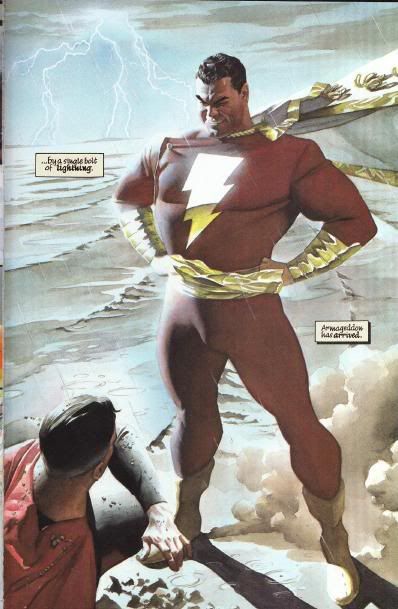
art by Alex Ross